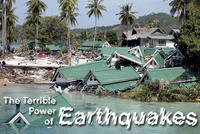Login form
Earthquakes
 What could be scarier than feeling the ground shake under your feet? Maybe this has happened if you live in a place that has earthquakes. The furniture shakes. Pictures drop from walls. Books fall off shelves. In really big quakes, roads can crumple up. Buildings and bridges can even collapse. And people can be killed.
What could be scarier than feeling the ground shake under your feet? Maybe this has happened if you live in a place that has earthquakes. The furniture shakes. Pictures drop from walls. Books fall off shelves. In really big quakes, roads can crumple up. Buildings and bridges can even collapse. And people can be killed.
WHAT CAUSES AN EARTHQUAKE?
Earthquakes are movements in Earth’s crust. The crust is Earth’s rocky outer layer, the solid ground that we live on. Earth’s crust is broken up into many gigantic sections of rigid rock called plates.
The plates slide around slowly on a layer of hot, melted rock deep inside Earth. Sometimes the plates crash together. Sometimes the edge of one plate slides under another plate.
Faults are cracks in Earth’s crust between the huge plates. Earthquakes usually happen along faults. The plates on each side of a fault press against each other with tremendous force. An earthquake occurs when the rock along the edge suddenly gives way. Huge chunks of rock underground break and move. They can jolt upward or they can dive down. Sometimes the blocks of rock along a fault grind sideways past each other.
The place where the rock breaks is called the focus of the earthquake. It is usually underground. The breaking and moving makes waves travel through the ground. The waves go through the ground the way waves go through water. The ground ripples and shakes.
The place on the ground directly above the focus is called the epicenter. Earthquakes are strongest near their epicenters. Earthquake waves go out in big circles. Waves made by a powerful earthquake can travel thousands of miles!
WHERE DO EARTHQUAKES HAPPEN?
Earthquakes are most common in places where Earth’s plates bump against each other. More earthquakes happen in the area around the Pacific Ocean than anywhere else. The plate that makes up the bottom of the Pacific is constantly squeezed by the surrounding plates. The pressure causes earthquakes around the edges of the plate.
The edge of the Pacific plate runs along the western coast of North and South America. Japan, China, eastern Russia, and the countries of Southeast Asia lie on the other edge of the Pacific plate. All of these places have frequent earthquakes.
HOW POWERFUL ARE EARTHQUAKES?
Most earthquakes are small. The shaking is weak and lasts only a few seconds. You probably would not even notice a weak earthquake. Some earthquakes are very powerful. They cause a lot of shaking. The shaking can last for minutes. Powerful earthquakes destroy buildings, roads, and bridges.
Geologists (scientists who study the structure of Earth) can measure the power of earthquakes. They use seismographs (machines that record movements of Earth).
Geologists have scales that tell how powerful an earthquake is. The Richter scale uses a number to tell how powerful an earthquake is. An earthquake with a 3.5 on the Richter scale, for example, is strong enough for most people to notice. A 6.0 or higher earthquake is strong enough to cause damage to buildings.
HOW DO EARTHQUAKES CAUSE DAMAGE?
The movement of the ground during an earthquake makes buildings and bridges shake. If the buildings and bridges shake enough, they will fall down. Damaged buildings can catch on fire.
Earthquakes can also cause landslides. The shaking loosens rock and soil on the sides of mountains and hills. The soil and rock slides down. It can bury towns and neighborhoods.
Earthquakes can cause huge waves called tsunamis. Rock slipping along a fault under the ocean causes a tsunami. The sudden movement of the rock sends a shockwave through the water above it. It makes powerful waves of water on the ocean’s surface. The waves spread out across the ocean. When the waves reach shallow water near land they get bigger and taller. Tsunami waves can be 50 feet (15 meters) high! When a huge tsunami hits shore it causes terrible floods. The floods wash away cars and damage buildings. Many people can die when a tsunami hits land.
DO EARTHQUAKES HAPPEN OFTEN?
There are thousands of seismographs placed all over the world. The machines record about a million small earthquakes every year. There are about 20 medium-sized earthquakes each year. Very powerful earthquakes happen once every few years.
Earthquakes have killed several million people in the past 500 years. One of the worst earthquakes killed more than 240,000 people in China in 1976.
Source: Microsoft ® Encarta

